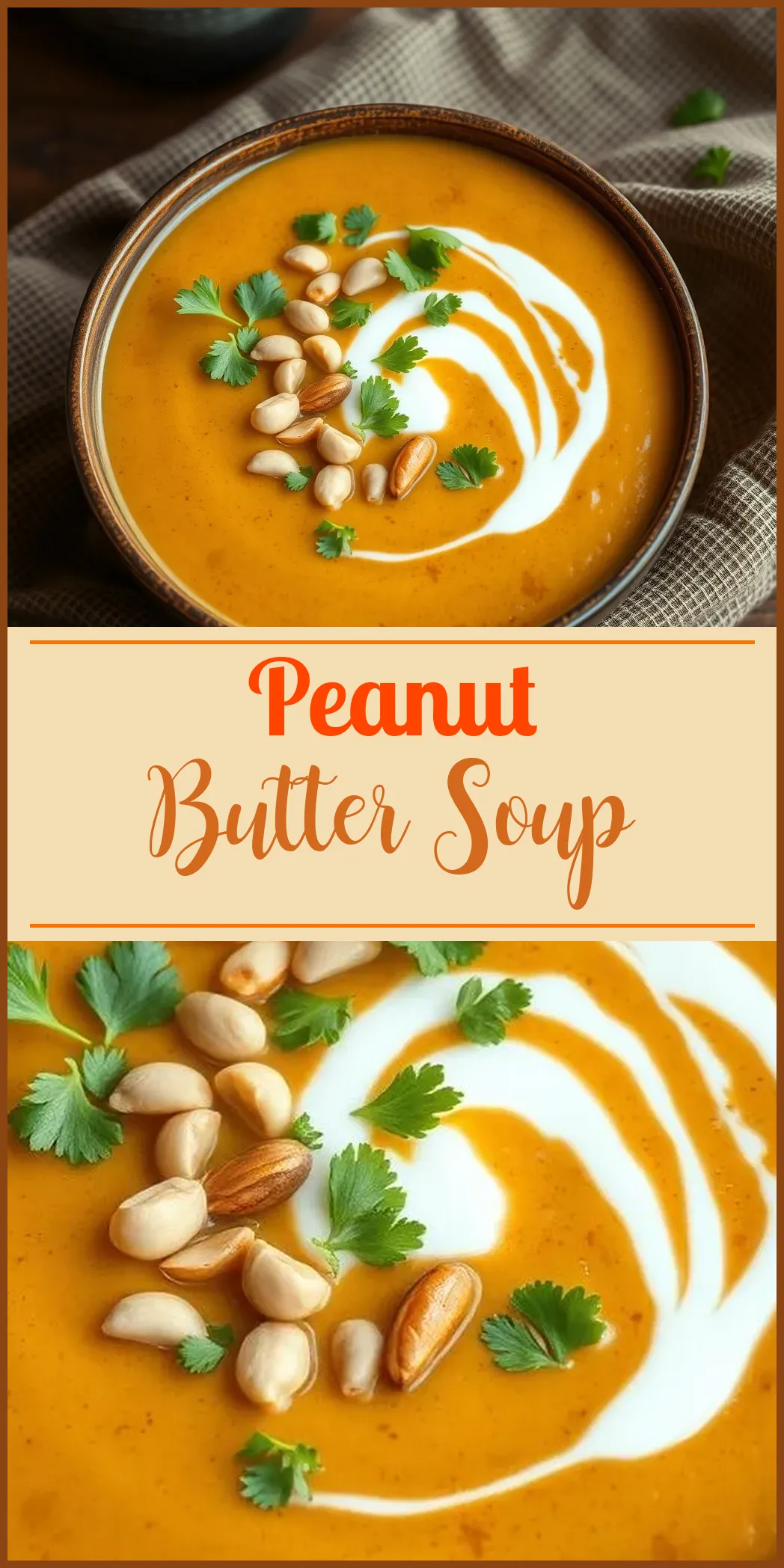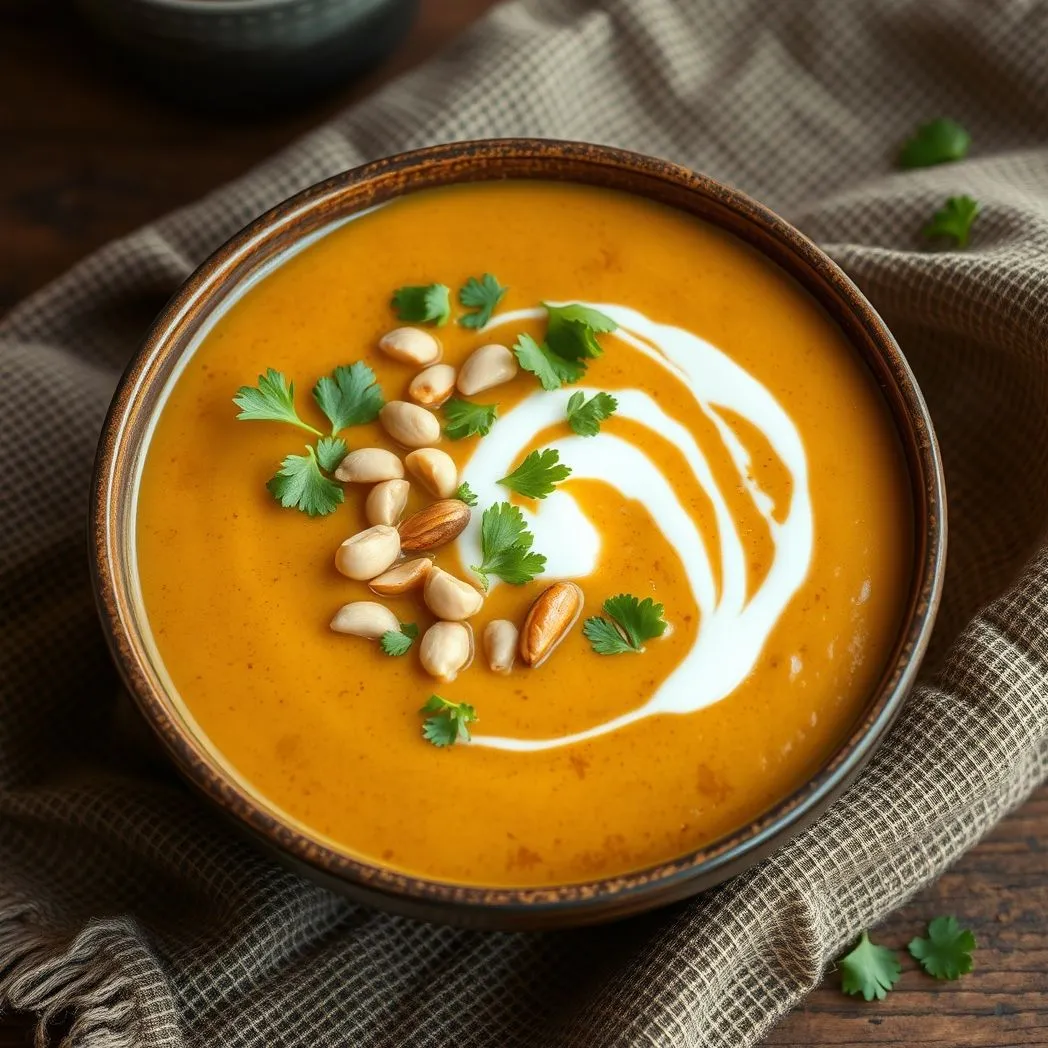Peanut Butter Soup has been capturing hearts and taste buds around the world. In its velvety, warming embrace, you can taste hints of tradition and innovation. This recipe draws inspiration from West African cuisine while adding personalized touches for modern kitchens. In this article, I will share a comprehensive guide covering every step—from assembling the ingredients to serving the final bowl of comfort. Whether you are new to cooking or an experienced chef, you will find tips, techniques, and ideas to make this soup uniquely yours.
A Brief Introduction
Peanut Butter Soup is not only rich in flavor but also steeped in tradition. Known in some areas as groundnut soup, it finds its roots in West Africa. Over time, this dish has evolved. I have adapted it to suit different taste preferences and occasions. The blend of natural peanut butter, sweet potatoes, tomatoes, and a mix of aromatic spices creates a balance of sweetness and savory notes. With each spoonful, you experience an exciting mix of textures and flavors.
The Story Behind the Soup
Historically, peanut-based dishes have been a cornerstone in numerous cultures. In West Africa, the soup has been a symbol of community and warmth. It has served as nourishment in both humble households and celebrated feasts. Today, chefs worldwide reinterpret this dish. I honor this tradition by keeping the recipe authentic while allowing for creative ingredients and garnishes.

Key Ingredients and Their Role
Understanding your ingredients is essential to mastering Peanut Butter Soup. Each element enhances the overall experience:
- Peanut Butter:
I prefer natural, creamy peanut butter. Its nutty flavor and rich texture serve as the soup’s heart. - Olive Oil:
A good olive oil is perfect for sautéing the aromatics. It lays the foundation for developing savory depth. - Aromatics (Onions, Garlic, Ginger):
These ingredients create a fragrant base. They offer warmth and complexity. - Red Bell Pepper:
It adds a delicate sweetness and vibrant color. - Sweet Potatoes:
These give body and a smooth texture when simmered. - Diced Tomatoes & Tomato Paste:
They bring acidity and concentrated flavor. Tomatoes balance the richness of peanut butter. - Broth:
Use vegetable or chicken broth. It acts as your liquid base. Start with a few cups and adjust for consistency. - Seasonings (Cumin, Cayenne, Salt, Pepper):
These spices are key. They create a blend that compliments the nutty essence of the soup. - Collard Greens or Alternate Greens:
I often opt for collard greens. Their slightly bitter notes contrast beautifully with sweet ingredients. - Optional Proteins:
You may add shredded chicken, tofu, or chickpeas. These ingredients turn the soup into a hearty meal.
Step-by-Step Cooking Process
The making of Peanut Butter Soup is a dance of flavors and textures. Follow these steps for a foolproof process:
1. Preparing the Base
Begin by heating olive oil in a large pot. Add chopped onions and red bell pepper. Sauté them on medium heat until they turn soft and slightly caramelized—about five minutes. This step extracts the natural sweetness of these vegetables.
2. Building Aromatics
Next, incorporate minced garlic and freshly grated ginger. Add spices like cumin and cayenne. Stir continuously for one to two minutes. This helps to bloom the spices and release their essential oils. Mix in tomato paste to deepen the color and flavor.
3. Incorporating Main Components
Pour in diced tomatoes and your choice of broth. Gradually stir in the peanut butter until you create a smooth blend. Then, add cubed sweet potatoes for body and texture. The peanut butter and vegetables must meld seamlessly for a velvety consistency.
4. Cooking and Simmering
Raise the heat to bring the mixture to a boil. Once boiling, reduce the heat and let it simmer. Allow it to cook until the sweet potatoes are tender. This process typically takes about 15 minutes. A short simmer helps in fusing the flavors without losing the brightness of the ingredients.
5. Finishing Touches
If you prefer a smoother texture, I recommend using an immersion blender. Pulse a portion of the soup to blend some of the ingredients yet maintain a bit of texture. Toward the last few minutes, add chopped collard greens or your choice of leafy greens. They only need a few minutes to wilt, preserving their nutritional value and slight crunch.
6. Final Seasoning
Adjust with salt and pepper. Taste the soup and add a squeeze of citrus, like lemon or lime, if you desire an extra burst of freshness. Serve immediately while it remains warm and inviting.
Serving Suggestions and Garnishes
Peanut Butter Soup is versatile. Here are a few ideas on how to enjoy it:
- Over Rice:
Serve hot over fluffy white rice or brown rice for a hearty meal. - Crusty Bread:
Accompany with a slice of crusty bread. It works wonders for dipping. - Alternative Grains:
Consider quinoa or coconut rice for a twist on the traditional side. - Garnishes:
Top with roasted peanuts, chopped cilantro, or a dollop of plain yogurt. A sprinkle of chili flakes can also add a subtle heat.
Each serving can be tailored. For instance, if you crave a bit of tang, drizzle a small amount of lime juice just before enjoying your bowl.
Nutritional Benefits
While Peanut Butter Soup is primarily comfort food, it also packs nutritional benefits:
- Healthy Fats:
Peanut butter supplies monounsaturated fats that are heart healthy. - Vitamins and Minerals:
Sweet potatoes provide beta carotene and fiber. Greens add iron and calcium. - Protein:
With natural peanut butter, you get a boost of protein to help maintain muscle tone. - Antioxidants:
Tomatoes and bell peppers are rich in antioxidants. These help in fighting oxidative stress.
This recipe provides a balanced mix of macronutrients. I love knowing that each spoonful nourishes mind and body.
Customized Variations
One of the best parts about making Peanut Butter Soup is its adaptability. Here are some ideas to tweak the recipe:
Protein Boost
- Chicken:
Add gently shredded chicken for a more robust protein profile. - Plant-Based:
Tofu or chickpeas are excellent vegetarian options. - Seafood Twist:
Consider lightly poached shrimp or fish when you want a seafood variation.
Adjusting Thickness and Texture
- Richer Consistency:
Increase the amount of peanut butter. It makes the soup thicker. - Creamier Variation:
Blend part of the soup fully for additional creaminess. Leave some chunks for contrast.
Experimenting with Greens
You can replace collard greens with alternatives like:
- Spinach:
Spinach wilts quickly and adds a bright green hue. - Kale:
This hardy green requires longer cooking but introduces an earthy flavor. - Turnip Greens:
They mimic the texture of collards while offering a unique twist.
Essential Tips for Perfect Peanut Butter Soup
Making this soup is both fun and error-forgiving. Consider these pointers to ensure success:
- Natural Peanut Butter is Key:
Always opt for natural, unsweetened peanut butter. Processed varieties may disrupt the flavor balance. - Do Not Overcook Vegetables:
Sweet potatoes should remain tender yet intact. Overcooking can lead to a mushy texture. - Balance Flavors Carefully:
Adjust spices gradually—a little cayenne goes a long way. - Work in Batches if Needed:
If you add extra protein or additional greens, do so gradually. Tasting during the process helps maintain balance. - Maintain Consistency:
If the soup thickens too much during storage, add water or broth during reheating.
Storage and Leftover Tips
Peanut Butter Soup can be enjoyed fresh or saved for later:
- Refrigeration:
Store excess soup in airtight containers. It can remain in the fridge for 4-5 days. - Freezing:
For longer storage, freeze in portions. Use freezer-safe bags or containers. Remember to leave space at the top for expansion. - Reheating:
Reheat gently on the stove or in the microwave. Stir frequently to retain an even temperature. If you notice thickening, add a splash of broth.
Leftovers can taste even better after the flavors have melded overnight. Just be sure to adjust the seasoning after reheating.
Health Benefits and Enjoyment
I love how this soup turns a meal into a nourishing experience. It’s low in processed ingredients yet rich in flavor. The natural fats from peanut butter support heart health. Additionally, the vegetables supply essential nutrients and antioxidants. A well-prepared bowl of Peanut Butter Soup is not just lunch or dinner—it’s a small celebration of wellness.
Bringing It All Together
In every bowl of Peanut Butter Soup, you encounter history, tradition, and personal creativity. The process is straightforward yet flexible. I invite you to enjoy this dish with your favorite garnishes and sides. Experiment with extra herbs or try alternative proteins to match your taste and dietary needs.
I often share this recipe at gatherings. It has the warmth of homemade cooking while being adaptable enough for any occasion. Your experience in preparing this soup will likely inspire you to experiment with new ingredients next time.
Final Words
Cooking is an art and a science. Peanut Butter Soup is a brilliant example of how classic ingredients can create a modern, flavorful dish. I encourage you to embrace this recipe. Let its rich, creamy texture uplift your meals during cold weather or whenever you crave a comforting bowl of goodness.
Enjoy every step of the process. Savor the aromas and flavors as they come together in your kitchen.
Happy cooking, and may each bowl bring you comfort and joy.

Peanut Butter Soup
This rich and creamy West African peanut butter soup blends tender sweet potatoes and leafy greens. It features warm spices for a hearty, flavor-packed meal.
Ingredients
- 1 cup creamy peanut butter
- 2 sweet potatoes, peeled and cubed
- 6 cups vegetable or chicken broth, divided
- 1 tablespoon tomato paste
- 1/2 teaspoon cayenne pepper, optional
- roasted peanuts and fresh cilantro, for serving
- 1 tablespoon fresh ginger, grated
- 1 (14 ounce) can diced tomatoes
- salt and pepper, to taste
- 4 cups collard greens or kale, stems removed and leaves chopped
- 1 tablespoon olive oil
- 1 large onion, diced
- 2 teaspoons ground cumin
- 3 cloves garlic, minced
- 1 red bell pepper, diced
Instructions
- In a large pot or Dutch oven, warm the olive oil over medium heat. Add the onion and pepper. Cook until soft, about 5 minutes. Stir in the garlic, ginger, cumin, cayenne, and tomato paste. Cook for 1-2 minutes, stirring constantly.
- Add the diced tomatoes. Then, add 5 cups of broth and peanut butter. Mix until smooth. After that, add the sweet potato cubes.
- Bring the soup to a boil. Reduce the heat to low. Cook until the potatoes are tender, about 15 minutes. If desired, use an immersion blender to puree some or all of the soup.
- Add the collard greens. Cook for an additional 5 minutes. They should be wilted but still bright in color. If needed, add more broth to thin the soup.
- Carefully taste the dish. Season with salt and pepper, as needed. Serve it hot. Accompany it with crusty bread, roasted peanuts, and fresh cilantro for garnish. Enjoy!

